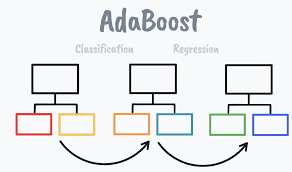Boost Your Machine Learning Models with AdaBoost
 Sahil Chandel
Sahil Chandel
In the world of machine learning, there’s always a quest for higher accuracy and better model performance. Whether you’re working on classification tasks or structured data projects, sometimes a single model just isn’t enough to get the results you need. That’s where ensemble methods come into play. Enter AdaBoost, a game-changing technique that often flies under the radar but can have a massive impact on your model’s performance.
In this article, we'll break down what AdaBoost is, why you should use it, and how you can implement it in your next project. Ready to boost your skills? Let’s dive in! 🚀
What is AdaBoost?
AdaBoost, short for Adaptive Boosting, is an ensemble technique that combines several weak learners to form a strong learner. It was one of the first successful boosting algorithms, and it continues to be a favorite for many data scientists. The idea is simple: it takes multiple weak models (typically decision trees with just one level, also known as decision stumps) and improves them by focusing on the data points where the model struggles.
AdaBoost adapts to the errors made by previous classifiers, assigning higher weights to incorrectly classified instances. As a result, the next classifier focuses on these tough-to-predict cases, improving overall performance. This approach has proven to be highly effective in creating powerful models from weak learners.
Why AdaBoost is a Must-Try for Your Next Project
Here are a few key reasons why you should consider using AdaBoost:
Handles Hard-to-Classify Cases: AdaBoost focuses on the data points your model finds difficult to predict, making your overall model much more robust.
Lightweight and Efficient: Unlike more complex ensemble methods like Gradient Boosting or Random Forests, AdaBoost is relatively lightweight and easy to implement.
Improves Accuracy: By concentrating on the hard-to-predict samples, AdaBoost can significantly boost your model’s accuracy with minimal additional complexity.
Great for Structured Data: AdaBoost works well on structured data and binary classification problems, but it can also be used in other contexts.
How Does AdaBoost Work?
Here’s a high-level breakdown of how AdaBoost functions:
Initialize Weights: All data points are initially given equal weights.
Train a Weak Learner: A weak learner, usually a decision stump (a simple decision tree), is trained on the data.
Assign Weights to Errors: After training, the model evaluates which data points it classified incorrectly and increases their weight.
Boost the Model: Another weak learner is trained, this time focusing more on the misclassified instances. This process repeats, gradually improving the model.
Final Model: The final AdaBoost model is a weighted sum of all weak learners, each learner contributing based on its accuracy.
Let’s Code: Implementing AdaBoost in Python
Here’s a quick guide on how you can implement AdaBoost using the AdaBoostClassifier from scikit-learn. This snippet also compares AdaBoost with Decision Trees and Random Forests to see how it stacks up:
pythonCopy codefrom sklearn.tree import DecisionTreeClassifier
from sklearn.ensemble import AdaBoostClassifier, RandomForestClassifier
from sklearn.metrics import accuracy_score, f1_score, precision_score, recall_score, roc_auc_score
# Define models
models = {
"Decision Tree": DecisionTreeClassifier(),
"Random Forest": RandomForestClassifier(),
"AdaBoost": AdaBoostClassifier()
}
# Train and evaluate each model
for model_name, model in models.items():
model.fit(X_train, y_train) # Train the model
y_test_pred = model.predict(X_test) # Make predictions
# Evaluate performance
accuracy = accuracy_score(y_test, y_test_pred)
f1 = f1_score(y_test, y_test_pred, average='weighted')
precision = precision_score(y_test, y_test_pred)
recall = recall_score(y_test, y_test_pred)
roc_auc = roc_auc_score(y_test, y_test_pred)
# Print results
print(f"Model: {model_name}")
print(f"Accuracy: {accuracy:.4f}")
print(f"F1 Score: {f1:.4f}")
print(f"Precision: {precision:.4f}")
print(f"Recall: {recall:.4f}")
print(f"ROC AUC: {roc_auc:.4f}")
print("="*40)
In the snippet above, we compare AdaBoost with Decision Trees and Random Forests, measuring key metrics such as:
Accuracy: The ratio of correct predictions to total predictions.
F1 Score: The harmonic mean of precision and recall.
Precision: The proportion of positive predictions that are correct.
Recall: The proportion of actual positives that are identified correctly.
ROC AUC: The area under the ROC curve, giving insight into the model’s performance across different classification thresholds.
AdaBoost in Action: Real-World Impact
In real-world use cases, AdaBoost has been widely applied in fields like fraud detection, medical diagnosis, and image recognition. It’s especially useful when working with large datasets where certain patterns are hard to detect using traditional methods. Since it is highly adaptive, AdaBoost often produces models that outperform more complex algorithms while remaining easy to interpret.
Pro Tips to Boost Your AdaBoost Models
Parameter Tuning: Adjusting parameters like the number of estimators (
n_estimators) and learning rate (learning_rate) can significantly impact your model's performance.Weak Learners: While decision stumps are the standard choice, you can experiment with other weak learners like support vector machines (SVMs) or even k-nearest neighbors (KNN) for more complex tasks.
Data Quality: AdaBoost is sensitive to noisy data, so make sure to clean your dataset and handle outliers properly.
Conclusion: Give Your Models a Boost!
AdaBoost is a powerful and efficient technique that can transform weak models into strong performers. Whether you're trying to increase your model's accuracy, tackle hard-to-classify instances, or simply streamline your workflow, AdaBoost is an ensemble method that delivers results without the computational overhead of more complex algorithms.
So, the next time you're building a machine learning model, give AdaBoost a try—it might just be the boost your project needs. 🚀
Let’s Connect!
Have you used AdaBoost in your projects? Share your experiences in the comments, and let’s exchange ideas on how to push the boundaries of machine learning!
Subscribe to my newsletter
Read articles from Sahil Chandel directly inside your inbox. Subscribe to the newsletter, and don't miss out.
Written by
